Mtg Land That Gives Blue Black and Red
Lands are the single most important thing any Magic the Gathering deck has. They're the fuel that drives the game – if you don't have lands, you're not getting anywhere.
All lands work the same way: you can put one down each turn, and they usually can be tapped to give you mana of a certain colour. However, over the years, lands have developed from the humble basic lands to include dozens of different types: Shock lands, manlands, fetch lands, pain lands, true duals, reveal lands, the list goes on and. However, you're only likely to run into a few specific types in most decks, and so here is everything you need to know about the most common types of land found in Magic the Gathering.
Basic Lands
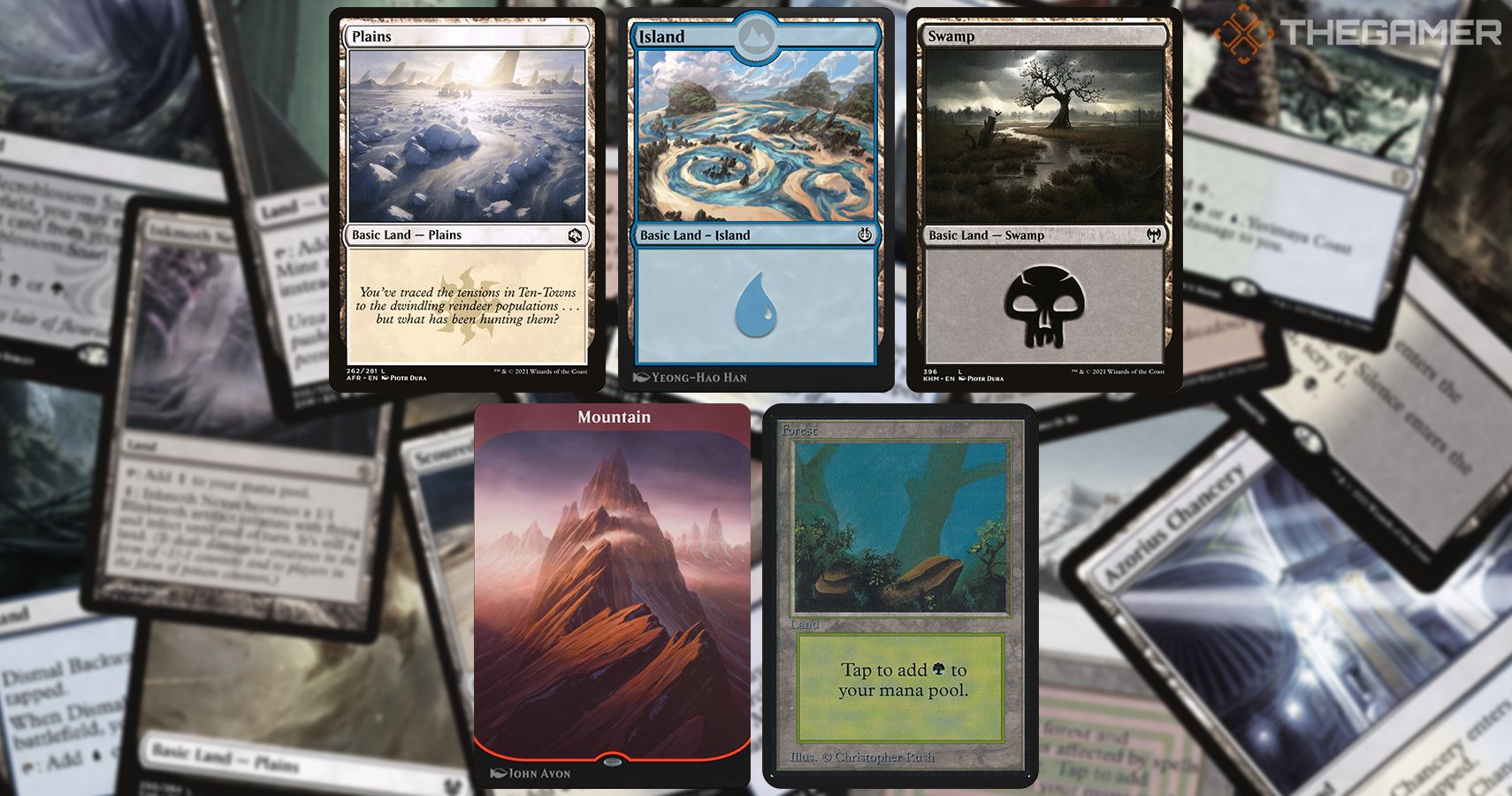
Basic lands are the most common type of card in the entire game. Your deck can run any amount of them, and the vast majority of booster packs come with at least one.
Basic lands come in six types, with each of the six producing a different type of mana when tapped: Plains produce white mana, Islands produce blue, Swamps produce black, Mountains produce red, Forests produce green, and Wastes produce colourless (and are much, much less common than the other five, having only appeared in one set).
Something to remember is that the ability to produce that colour of mana is inherent to that land type. If something is an Island, for example, it always has the ability to tap to produce blue mana, even if it doesn't explicitly say so on the card.
True Dual Lands
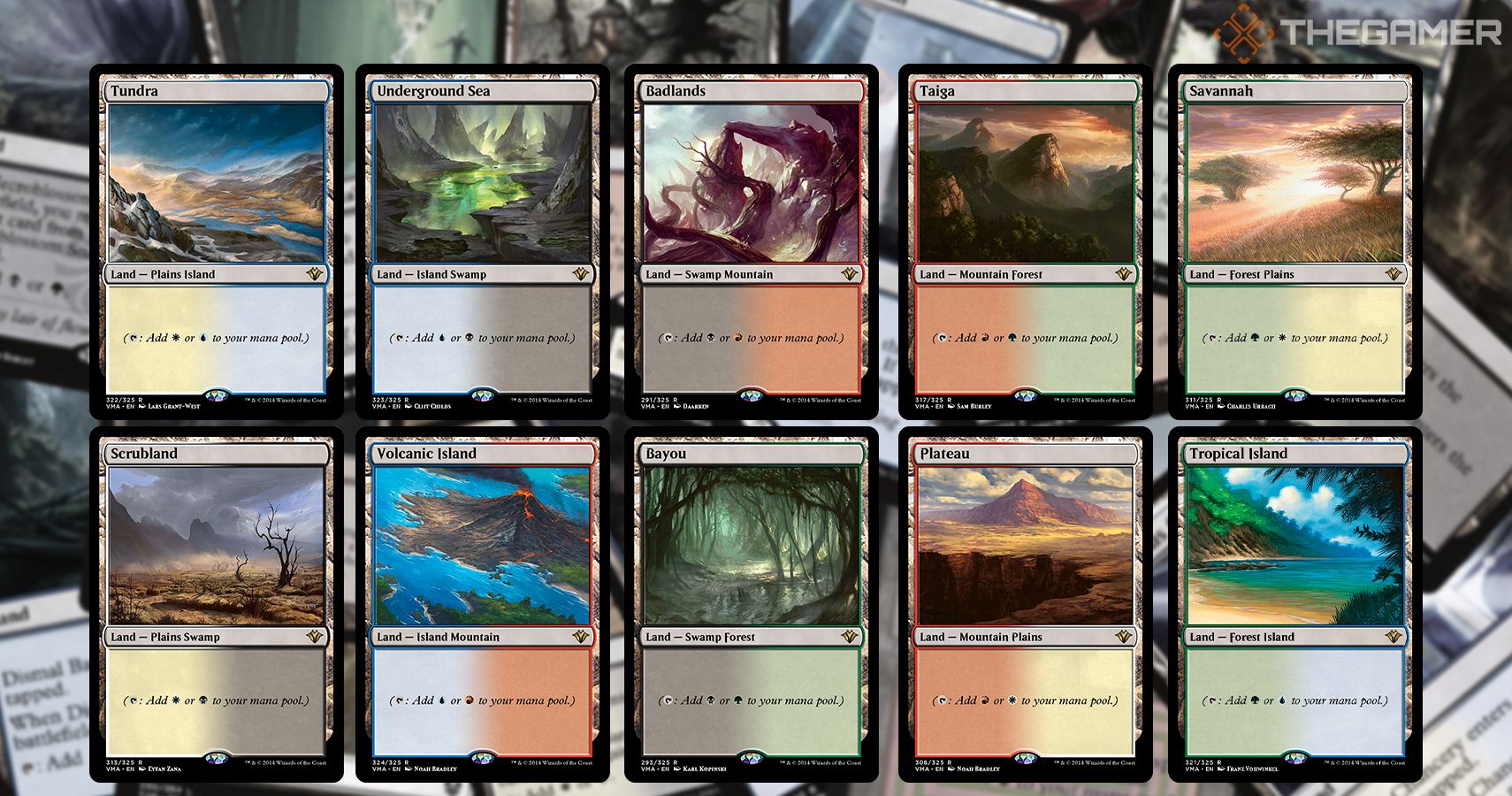
True Duals are the holy grail of lands, and are some of the most valuable cards in the entire game.
True Duals are lands that can produce two colours of mana, have both relevant land types, and can enter the battlefield untapped for free. There are ten true dual lands:
- Tundra: a Plains and Island that taps for white or blue.
- Scrubland: a Plains and Swamp that taps for white or black.
- Underground Sea: an Island and Swamp that taps for blue or black.
- Volcanic Island: an Island and Mountain that taps for blue or red.
- Badlands: a Swamp and Mountain that taps for black or red.
- Bayou: a Swamp and Forest that taps for black or green.
- Taiga: a Mountain and Forest that taps for red or green.
- Plateau: a Mountain and Plains that taps for red or white.
- Savannah: a Forest and Plains that taps for green or white.
- Tropical Island: a Forest and Island that taps for green or blue.
The reason True Duals are so powerful is because the land typing lets them be searched by a wide number of other cards. For example, a Gift of Estates can search your library for three Plains (note, not a basic Plains), letting you grab a Tundra, Savannah and Plateau. Lands with types are generally considered better than those that aren't because of this searchability.
Fetch Lands
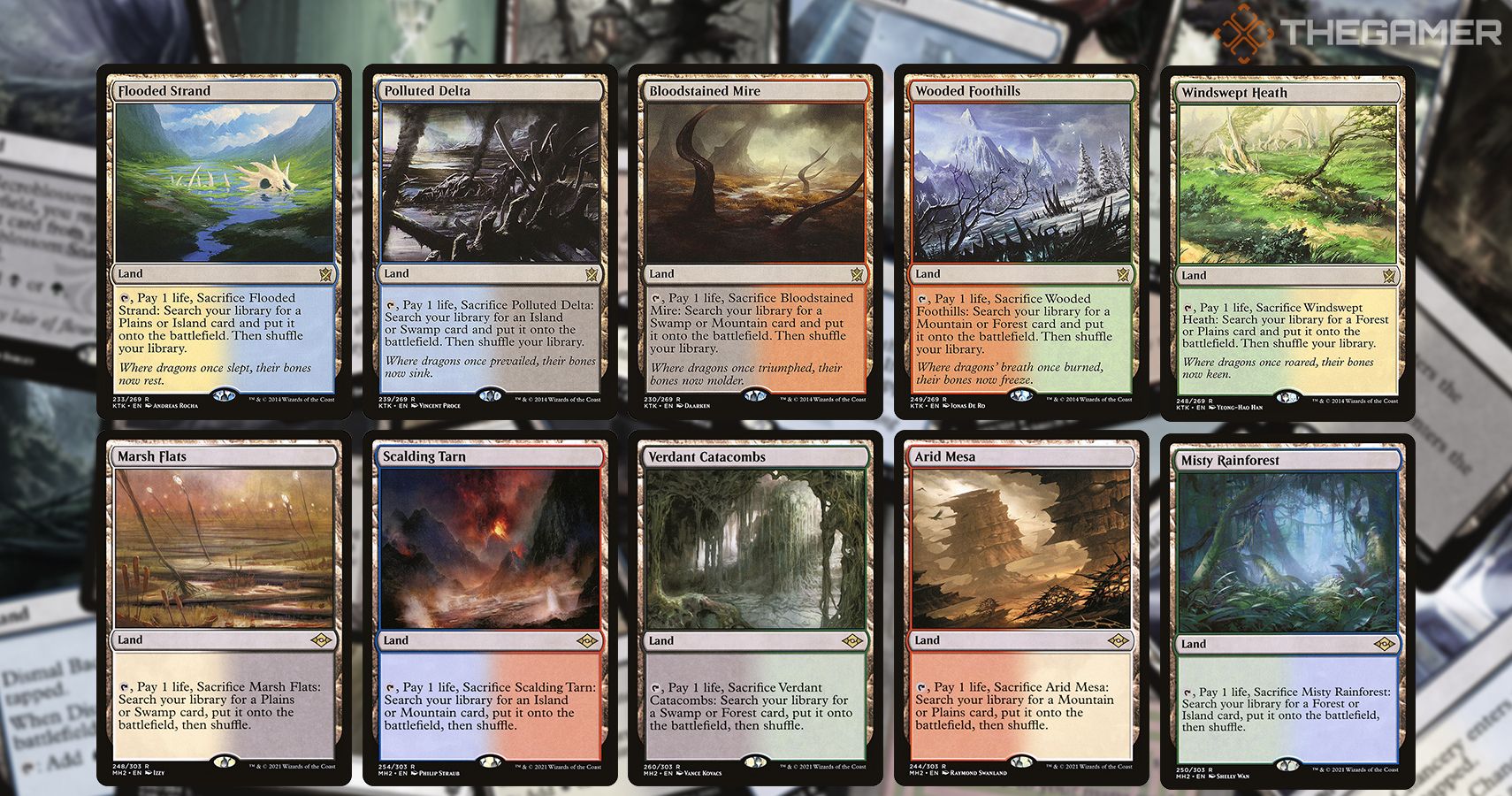
Speaking of searchability, another popular type of land are Fetch Lands. Most fetch lands don't tap for a colour of mana themselves, but can be sacrificed to search for a specific type of land.
There are lots of different Fetch Lands, but the best ones to know about are the Onslaught and Zendikar fetch lands. These let you tap them, sacrifice them, and pay one life to search your library for specific land types:
- Flooded Strand: search for a Plains or an Island.
- Polluted Delta: search for an Island or a Swamp.
- Bloodstained Mire: search for a Swamp or a Mountain.
- Wooded Foothills: search for a Mountain or Forest.
- Windswept Heath: search for a Forest or Plains.
- Marsh Flats: search for a Plains or Swamp.
- Verdant Catacombs: search for a Swamp or Forest.
- Misty Rainforest: search for a Forest or Island.
- Scalding Tarn: search for an Island or Mountain.
- Arid Mesa: search for a Mountain or a Plains.
There are also the Panoramas, one for each of the three Shards of Alara that let you pay one mana, tap and sacrifice them to search for one of that shard's three colours:
- Bant Panorama: search for a Forest, Plains or Island.
- Esper Panorama: search for a Plains, Island or Swamp.
- Grixis Panorama: search for an Island, Swamp or Mountain.
- Jund Panorama: search for a Swamp, Mountain or Forest.
- Naya Panorama: search for a Mountain, Forest or Plains.
While Fetch Lands are often quite expensive, there are a few that can search for any type of basic land that goes for quite cheap. These include Terramorphic Expanse, Evolving Wilds, and Fabled Passage.
Pure Taplands
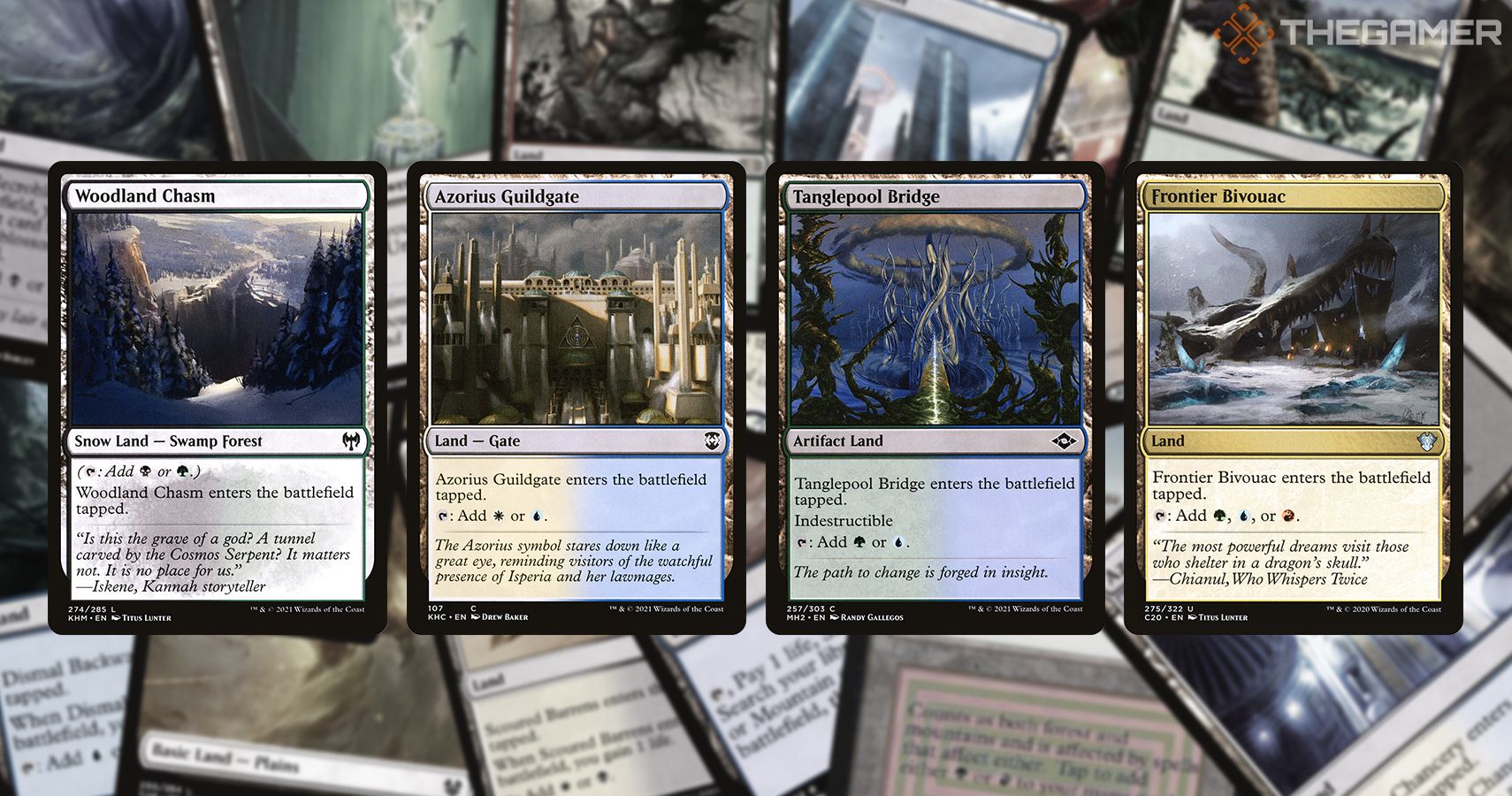
In Magic, 'taplands' are any land that enters the battlefield tapped. Some of them may allow you to make them enter untapped through some other means, such as Shock Lands or Reveal Lands.
Pure Taplands, though, don't. This is probably the most common type of dual land, but their lack of any upside to playing them makes them arguably less popular than any other kind. These are a budget option if you really need multi-colour lands but don't want to fork out for something better.
While there are too many to list, as they have been given numerous functional reprints over the years, there are a few variants worth noting:
- Thriving Lands allow you to name your second colour, instead of it being fixed to the card.
- Kaldheim's Snow Taplands make snow mana and have the basic land types to make them searchable.
- Modern Horizons 2's Artifact Taplands count as artifacts (for mechanics such as Affinity) and are also indestructible.
- Gates tend to be seen as one of the worst dual lands you can play, but do serve a purpose in Maze's End decks where they are a potential win condition. You'll probably see this less in Commander now that Golos is banned.
- Triple Taplands can tap for any of the ten three-colour groups.
Shock Lands
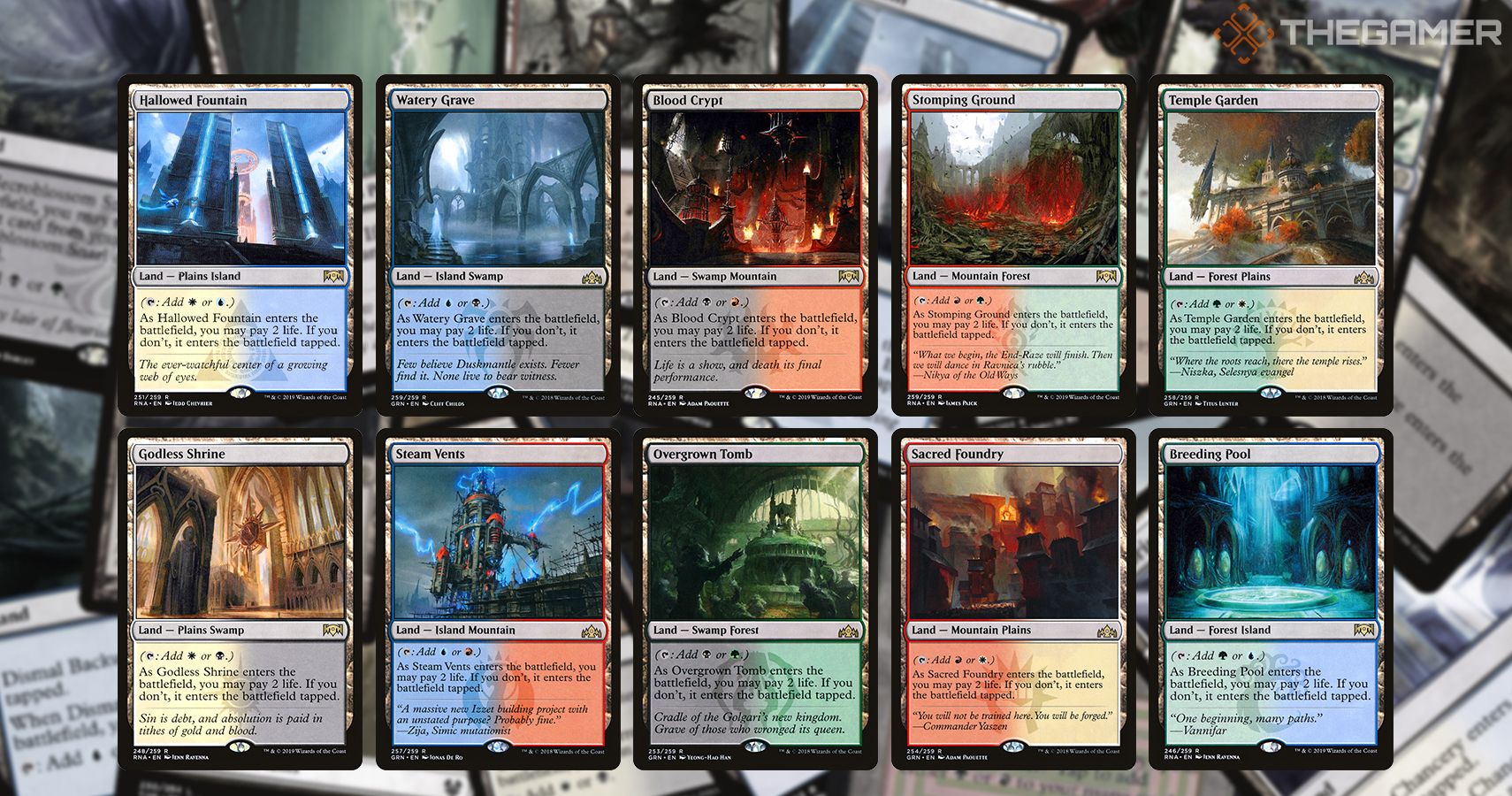
Shock Lands are a dual land that can let you pay two life to enter the battlefield untapped. If not, they enter tapped and can't be used that turn. Despite the drawback, shock lands are incredibly popular because they have multiple land types and can make great turn one play. They can tap for either colour of their land types.
The Shock Lands are:
- Hallowed Fountain: Plains and Island.
- Watery Grave: Island and Swamp.
- Blood Crypt: Swamp and Mountain.
- Stomping Ground: Mountain and Forest.
- Temple Garden: Forest and Plains.
- Godless Shrine: Plains and Swamp.
- Steam Vents: Island and Mountain.
- Overgrown Tomb: Swamp and Forest.
- Sacred Foundry: Mountain and Plains.
- Breeding Pool: Forest and Island.
Battle Lands
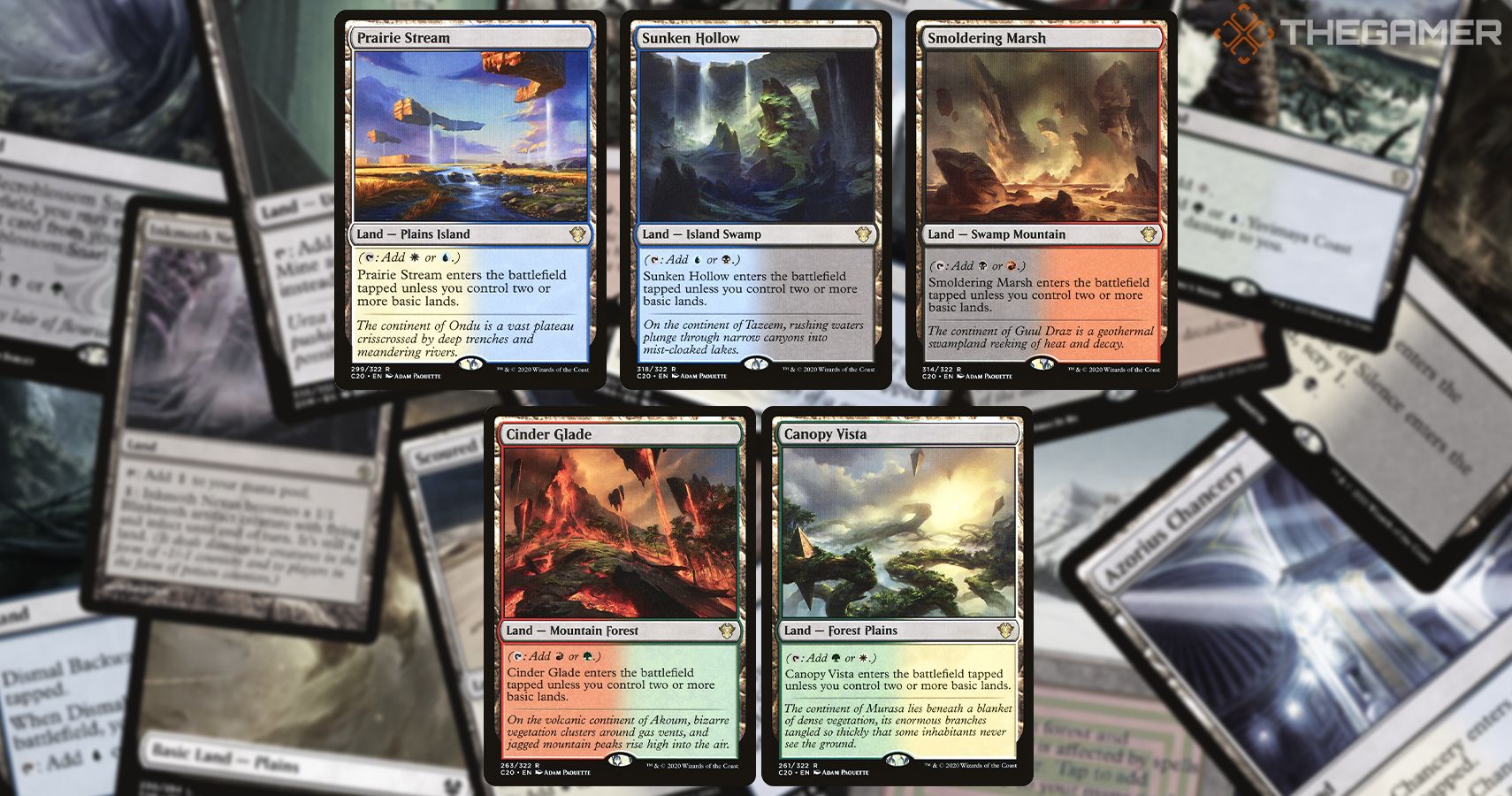
Battle Lands (also known as Tango Lands) can only enter the battlefield untapped if you control two or more basic lands (of any type). While that makes them poorer turn one plays, later in the game their use of multiple land types makes them popular targets for fetch lands.
- Prairie Stream: Plains and Island.
- Sunken Hollow: Island and Swamp.
- Smoldering Marsh: Swamp and Mountain.
- Cinder Glade: Mountain and Forest.
- Canopy Vista: Forest and Plains.
One of the major drawbacks of Battle Lands is that only half of the two-colour pairs are represented. The enemy colours, such as Orzhov (black/white) or Izzet (blue/red) don't have their own Battle Lands.
Bond Lands
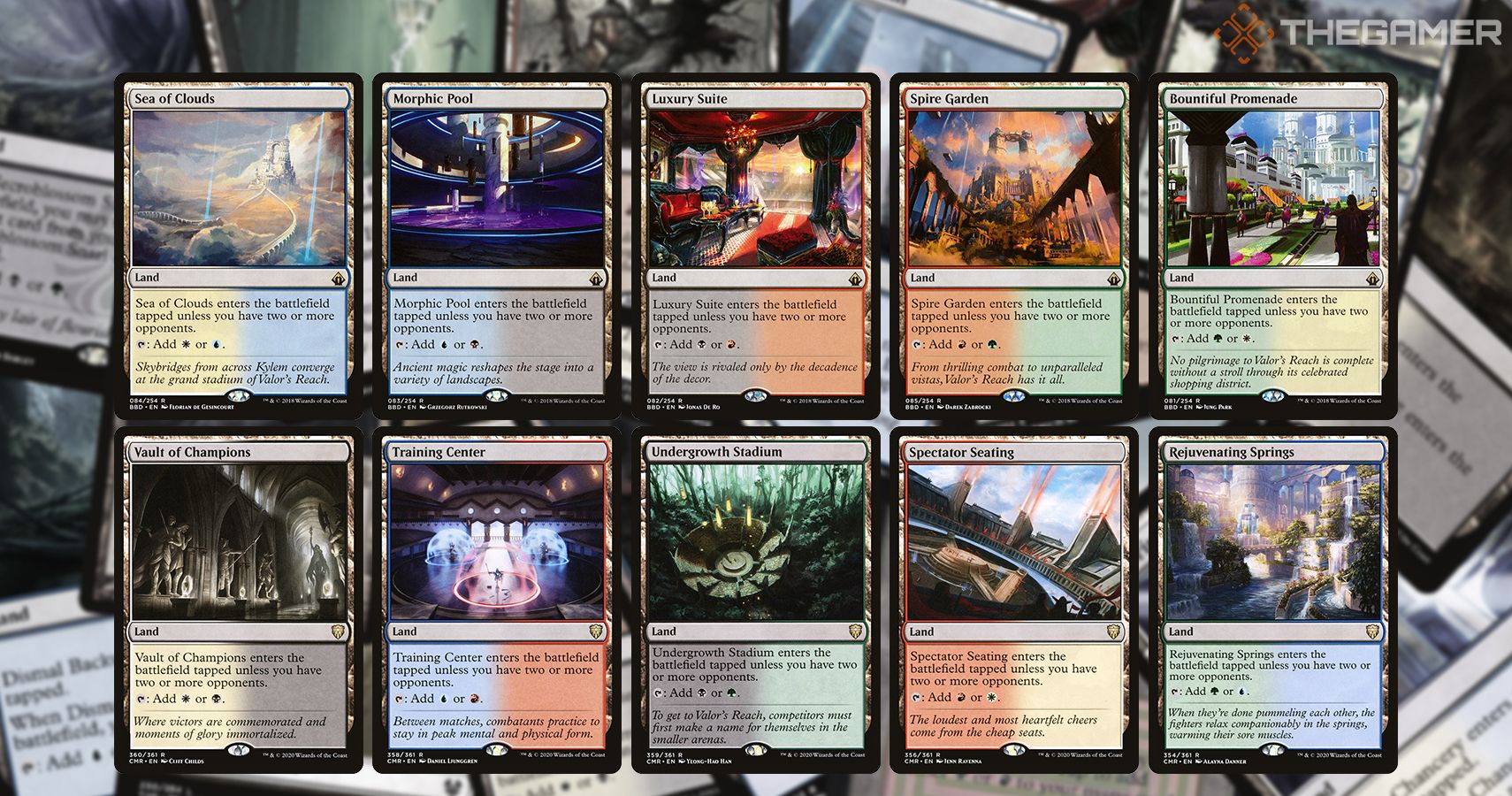
Bond lands are designed specifically for multiplayer formats, like Two-Headed Giant or Commander, where they are very popular. They enter the battlefield untapped as long as you have two or more opponents currently in play, leading them to sometimes also be known as 'Crowd Lands':
- Sea of Clouds: white or blue.
- Morphic Pool: blue or black.
- Luxury Suite: black or red.
- Spire Garden: red or green.
- Bountiful Promenade: green or white.
- Vault of Champions: white or black.
- Training Center: blue or red.
- Undergrowth Stadium: black or green.
- Spectator Seating: red or white.
- Rejuvenating Springs: green or blue.
Bounce Lands
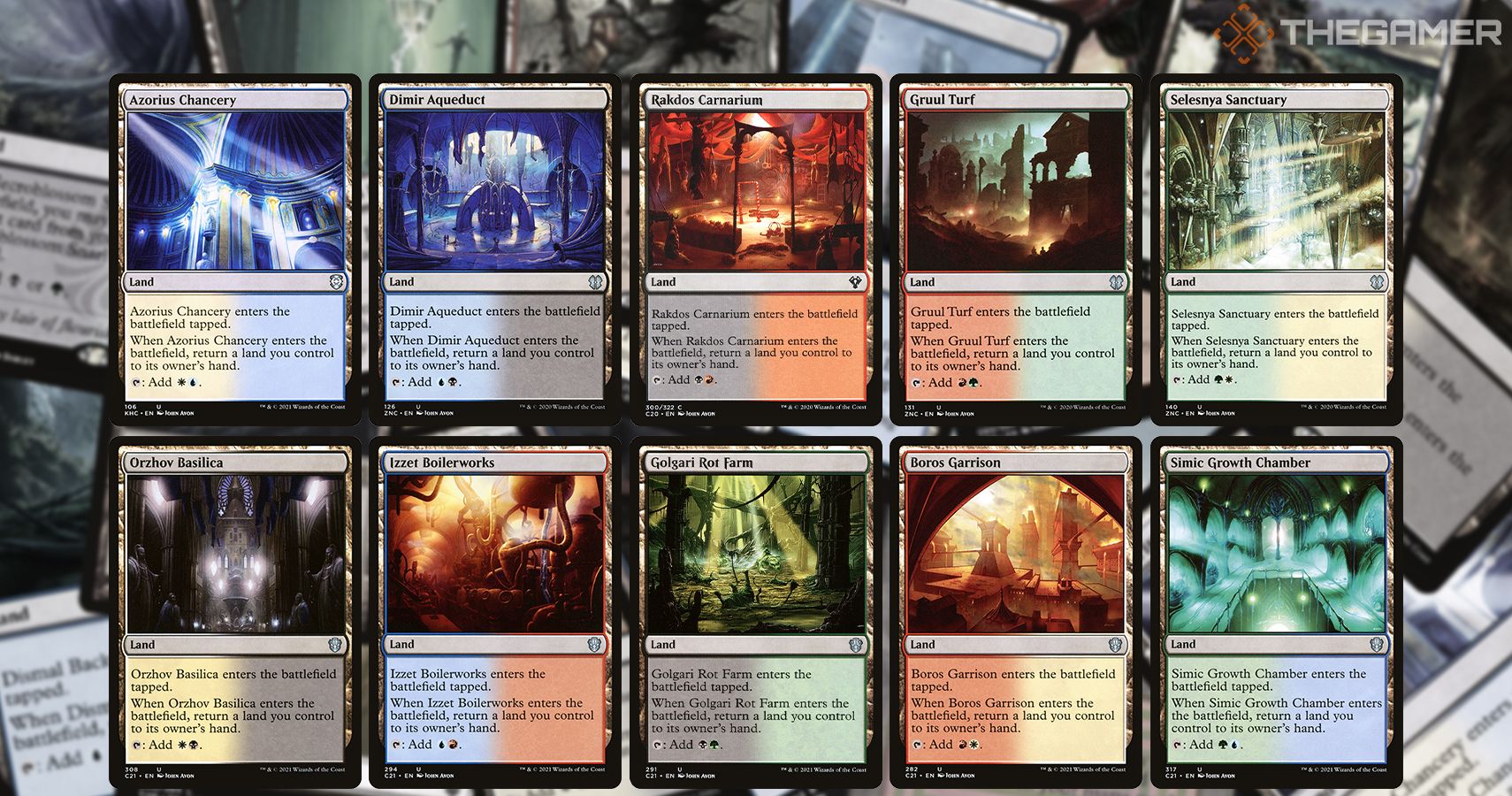
Even though they don't have the multiple land typings of more expensive lands, Bounce Lands are still very popular because of their lower cost and ability to produce more than one mana at a time.
When a Bounce Land enters the battlefield under your control, you must return a land to your hand (bouncing it). Bounce lands also enter the battlefield tapped, so you can't use them the same turn they are played. That makes them a considerable mana cost to play, but are worth it in the long turn.
There are five mono-colour Bounce Lands that each produce one colour and one colourless mana:
- Karoo: white and colourless.
- Coral Atoll: blue and colourless.
- Everglades: black and colourless.
- Dormant Volcano: red and colourless.
- Jungle Basin: green and colourless.
There are also ten two-colour Bounce lands, each based on one of the Guilds of Ravnica:
- Azorius Chancery: white and blue.
- Dimir Aqueduct: blue and black.
- Rakdos Carnarium: black and red.
- Gruul Turf: red and green.
- Selesnya Sanctuary: green and white.
- Orzhov Basilica: white and black.
- Izzet Boilerworks: blue and red.
- Golgari Rot Farm: black and green.
- Boros Garrison: red and white.
- Simic Growth Chamber: green and blue.
While not officially considered Bounce Lands, there are also the three-colour Lairs. Unlike bounce lands, Lairs have the Lair type, don't enter the battlefield tapped, and can tap for three colours based on the five Dominarian dragons:
- Treva's Ruins: green, white and blue.
- Dromar's Caven: white, blue and black.
- Crosis's Catacombs: blue, black and red.
- Darigaaz's Caldera: black, red and green.
- Rith's Grove: red, green and white.
Pain Lands
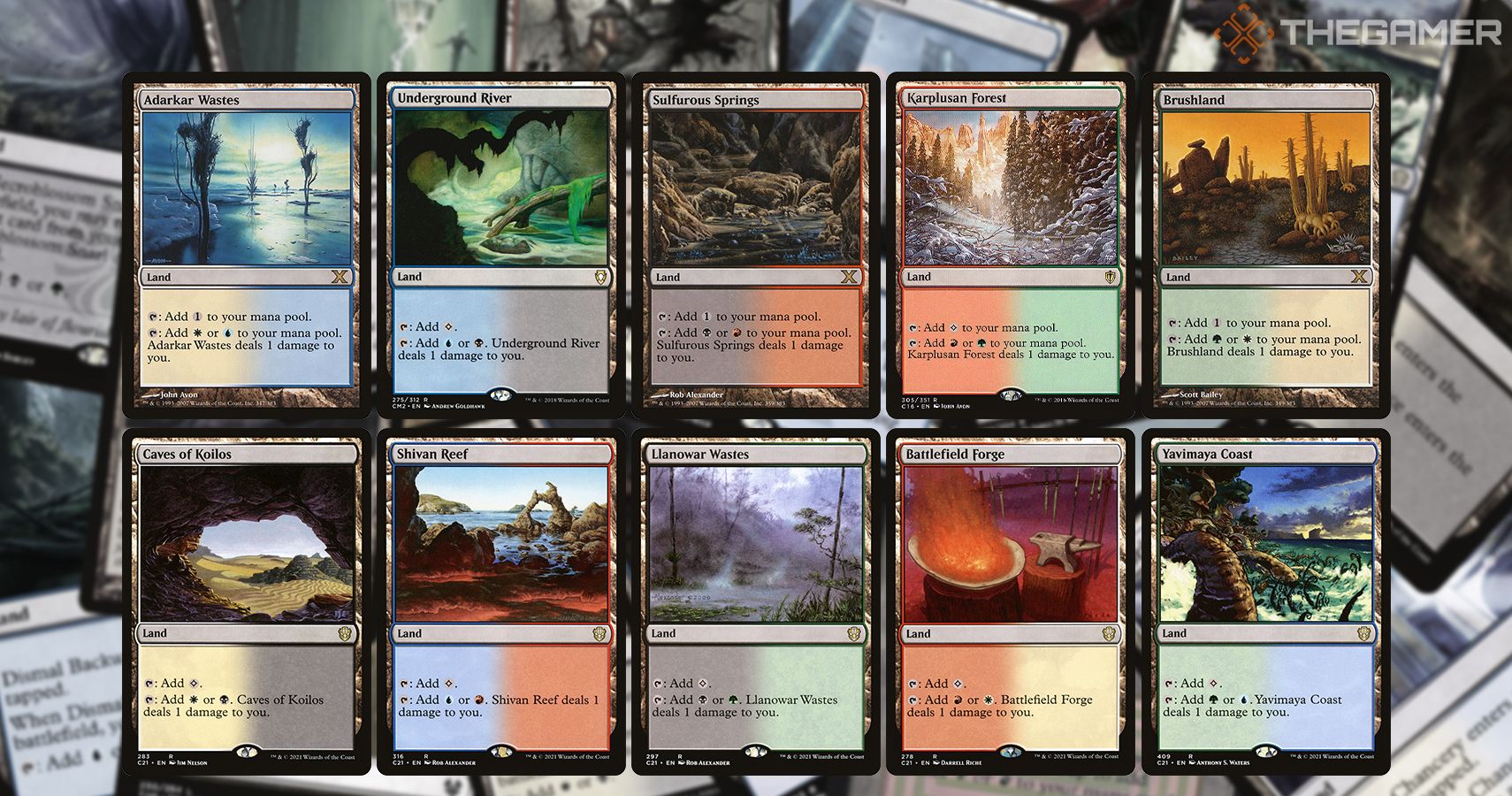
Pain lands are lands that can tap either tap for one colourless mana for free, or for one of two colours in exchange for dealing one damage to you. These do see some play despite that huge drawback, as they can enter the battlefield untapped and pay for generic mana costs with no downside.
There are lots of different pain lands, with the main ones being the original Pain Lands from Ice Age and Apocalypse:
- Adarkar Wastes: white or blue.
- Underground River: blue or black.
- Sulfurous Springs: black or red.
- Karplusan Forest: red or green.
- Brushland: green or white.
- Caves of Koilos: white or black.
- Shivan Reef: blue or red.
- Llanowar Wastes: black or green.
- Battlefield Forge: red or white.
- Yavimaya Coast: green or blue.
There are also six Pain Taplands, which enter the battlefield tapped and so are a considerable downgrade:
- Salt Flats: white or black.
- Caldera Lake: blue or red.
- Pine Barrens: black or green.
- Scabland: red or white.
- Skyshroud Forest: green or blue.
- Grand Coliseum: any colour.
Scry Lands
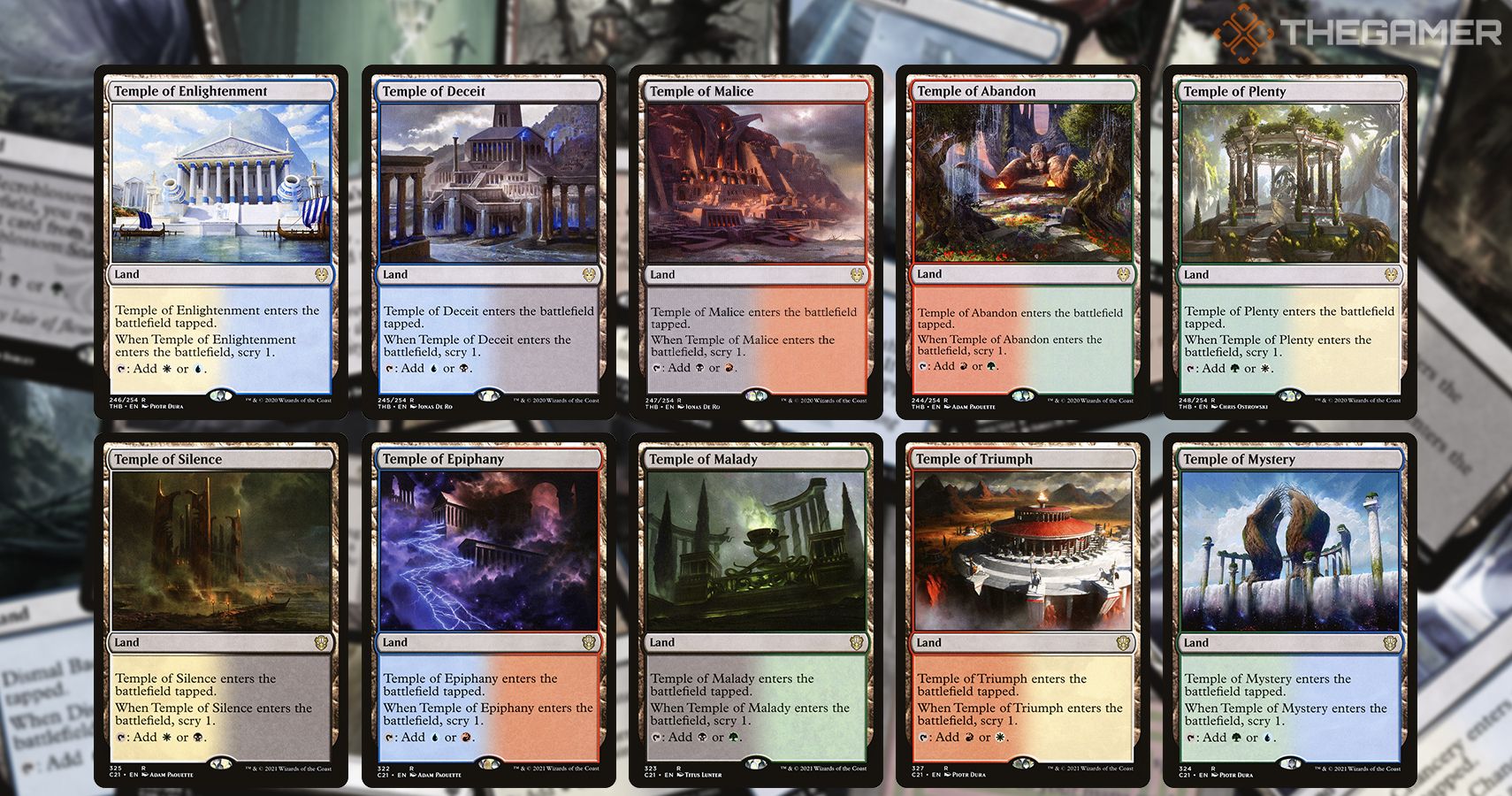
Used in sets based in Theros, Scry lands are a group of ten Temples that allow you to scry (look at the top card your library and either keep it on top or put it on the bottom). However, they enter tapped and lack the land typings, making them less popular choices. They are quite cheap, though.
- Temple of Enlightenment: white or blue.
- Temple of Deceit: blue or black.
- Temple of Malice: red or black.
- Temple of Abandon: red or green.
- Temple of Plenty: green or white.
- Temple of Silence: white or black.
- Temple of Epiphany: blue or red.
- Temple of Malady: black or green.
- Temple of Triumph: red or white.
- Temple of Mystery: green or blue.
Gain Lands
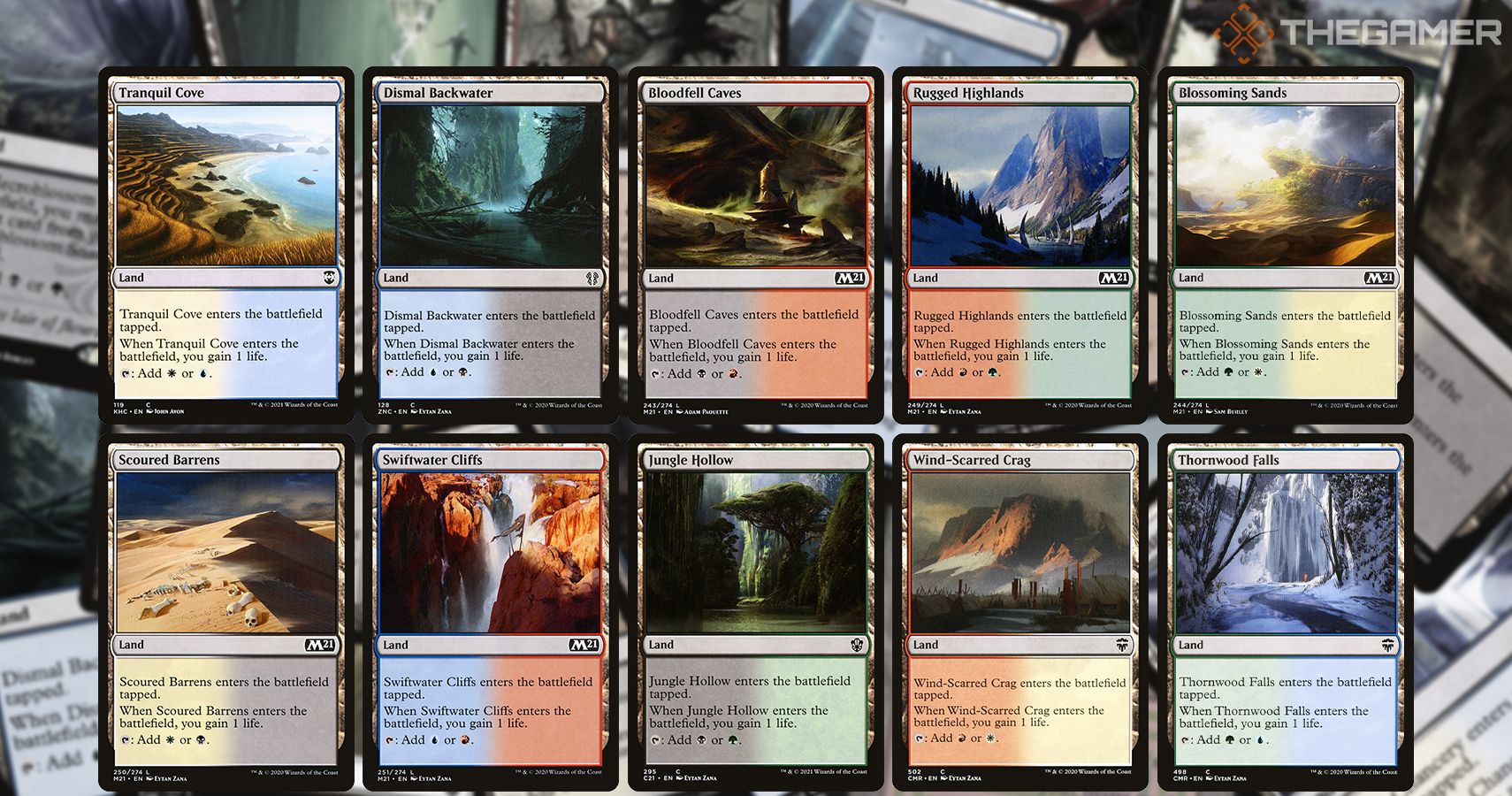
Like Scry Lands, Gain Lands are duals that lack the land typings and enter the battlefield tapped. However, when they do, you gain one life. These tend not to see much play outside of formats like Standard or Pauper, but they are very cheap.
Confusingly, the five allied colour lands got functional reprints in Khans of Tarkir, to distance themselves from the Zendikar-themed named they had before.
- Sejiri Refuge or Tranquil Cove: white or blue.
- Jwar Isle Refuge or Dismal Backwater: blue or black.
- Akoum Refuge or Bloodfell Caves: black or red.
- Kazandu Refuge or Rugged Highlands: red or green.
- Greypelt Refuge or Blossoming Sands: green or white.
- Scoured Barrens: white or black.
- Swiftwater Cliffs: blue or red.
- Jungle Hollow: black or green.
- Wind-Scarred Crag: red or white.
- Thornwood Falls: green or blue.
Reveal Lands
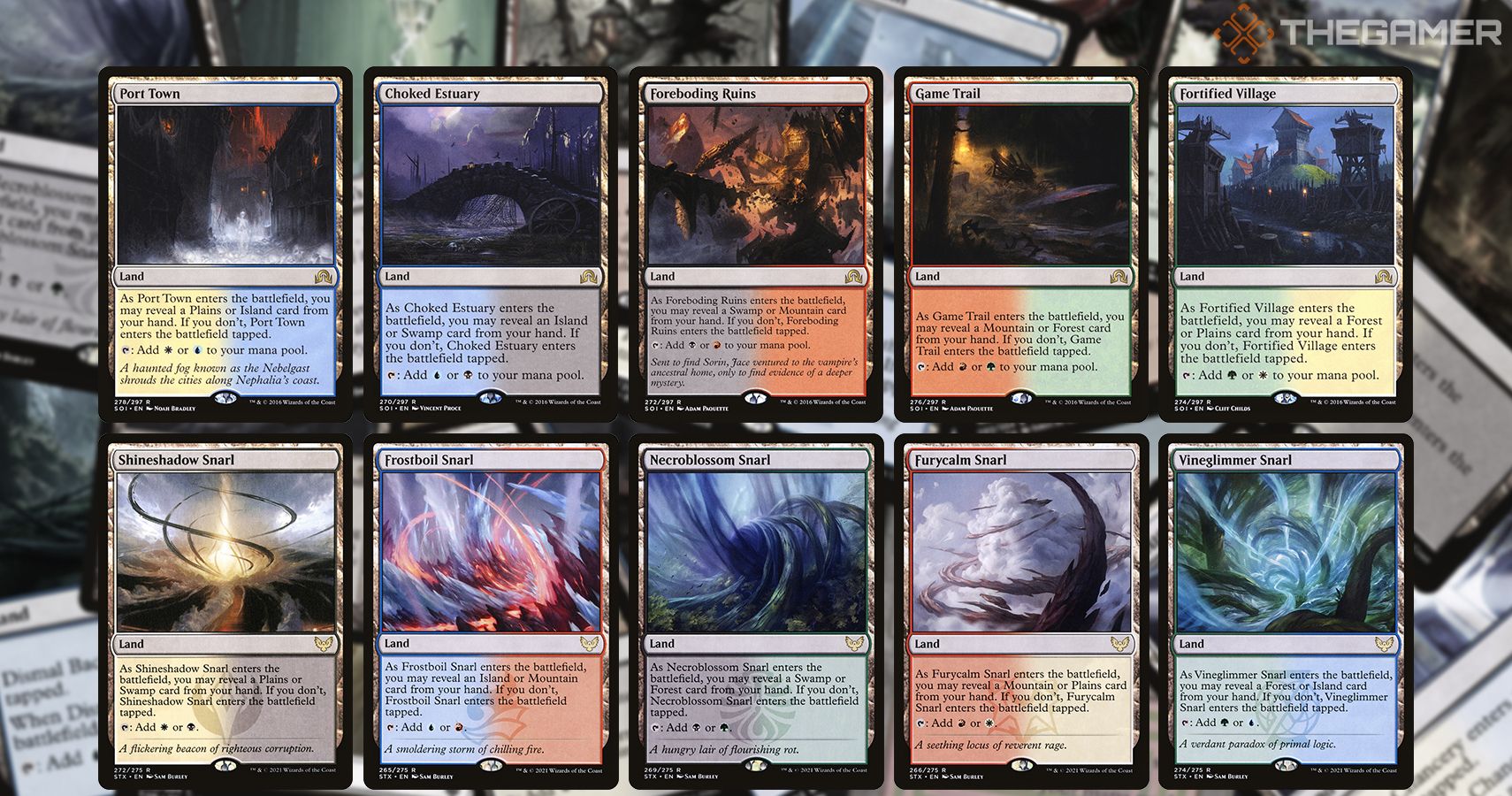
Reveal lands enter tapped unless you reveal a specific type of land from your hand. Despite not having the land types on them, they're still popular because of how they can allow for quick access to both colours of mana on turn one.
The allied colours show locations from Innistrad, while the enemy colours show wild, natural sources of Magic found in and around Strixhaven.
- Port Town: white or blue, reveal a Plains or an Island.
- Choked Estuary: blue or black, reveal, and Island or a Swamp.
- Foreboding Ruins: black or red, reveal a Swamp or a Mountain.
- Game Trail: red or green, reveal a Mountain or a Forest.
- Fortified Village: green or white, reveal a Forest or a Plains.
- Shineshadow Snarl: white or black, reveal a Plains or a Swamp.
- Frostboil Snarl: blue or red, reveal an Island or a Mountain.
- Necroblossom Snarl: black or green, reveal a Swamp or a Forest.
- Furycalm Snarl: red or white, reveal a Mountain or a Plains.
- Vineglimmer Snarl: green or blue, reveal a Forest or an Island.
Filter Lands

Filter Lands allow you to pay one mana of a colour to create two mana in a combination of it and another colour. For example, a Mystic Gate can take either one white or one blue to make two white, two blue, or one white and one blue.
Though cumbersome, they do see some play. More commonly, though, you'll see the cycle of artifacts based on them, the Ravnican Guild Signets.
The Filter Lands are:
- Mystic Gate: white or blue.
- Sunken Ruins: blue or black.
- Graven Cairns: black or red.
- Fire-lit Thicket: red or green.
- Wooded Bastion: green or white.
- Fetid Heath: white or black.
- Cascade Bluffs: blue or red.
- Twilight Mire: black or green.
- Rugged Prairie: red or white.
- Flooded Grove: green or blue.
Manlands
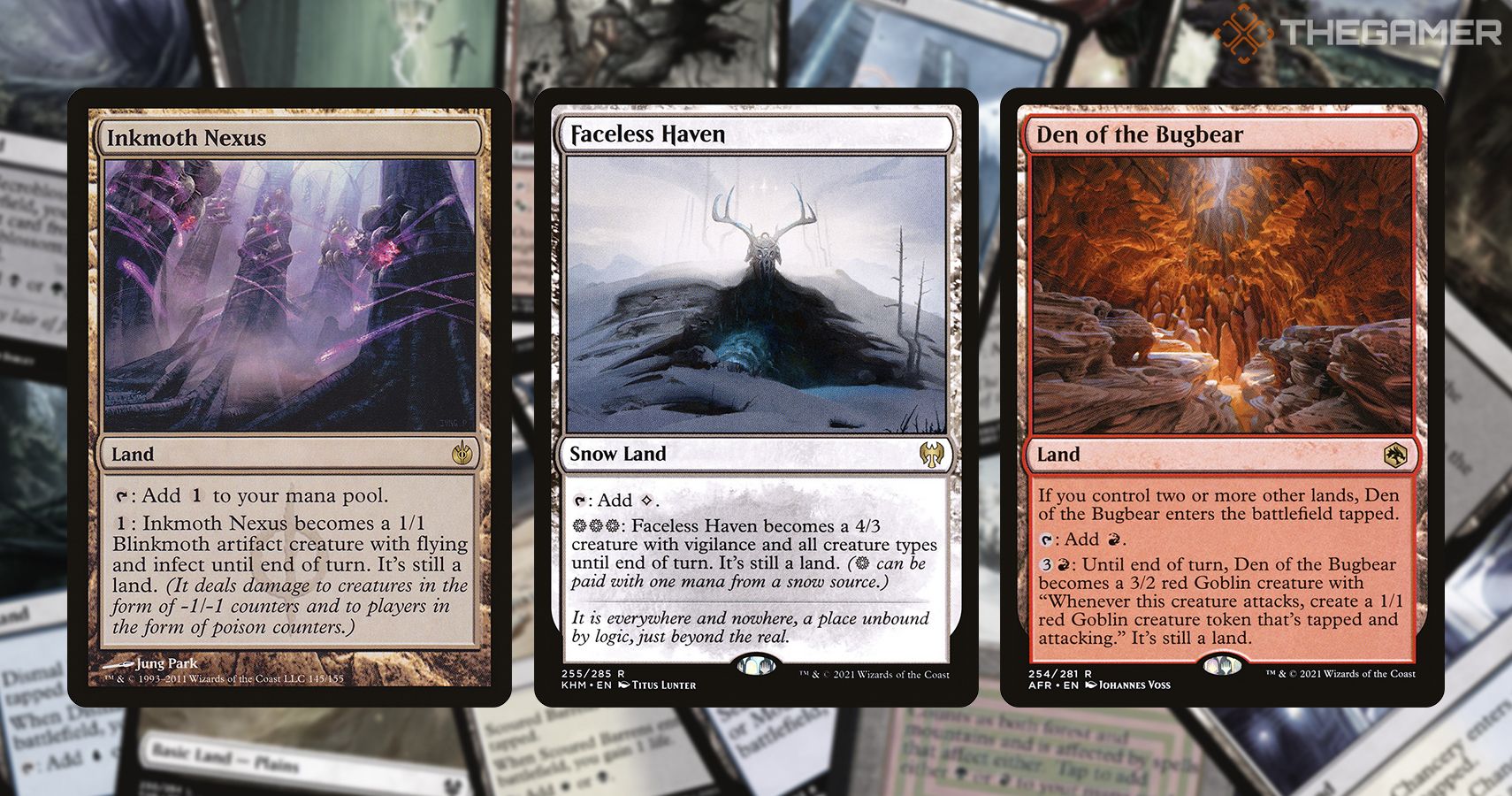
"Manland" is a collective term for any land that can temporarily become a creature. Like true taplands, there are a lot of these, however, there are a few key ones worth mentioning:
- Dungeons & Dragons: Adventure in the Forgotten Realms had one of each colour, with Cave of the Frost Dragon, Hall of the Storm Giants, Hive of the Eye Tyrant, Den of the Bugbear and Lair of the Hydra.
- Faceless Haven is causing some problems in Standard at the moment, due to it working well with The Book of Exalted Deeds to make a deck unlosable if your opponent isn't running any land destruction.
- Inkmoth Nexus is a land that can turn into a 1/1 flyer with infect, and is a part of a lot of rather nasty combos.
Urza Lands/Tron Lands
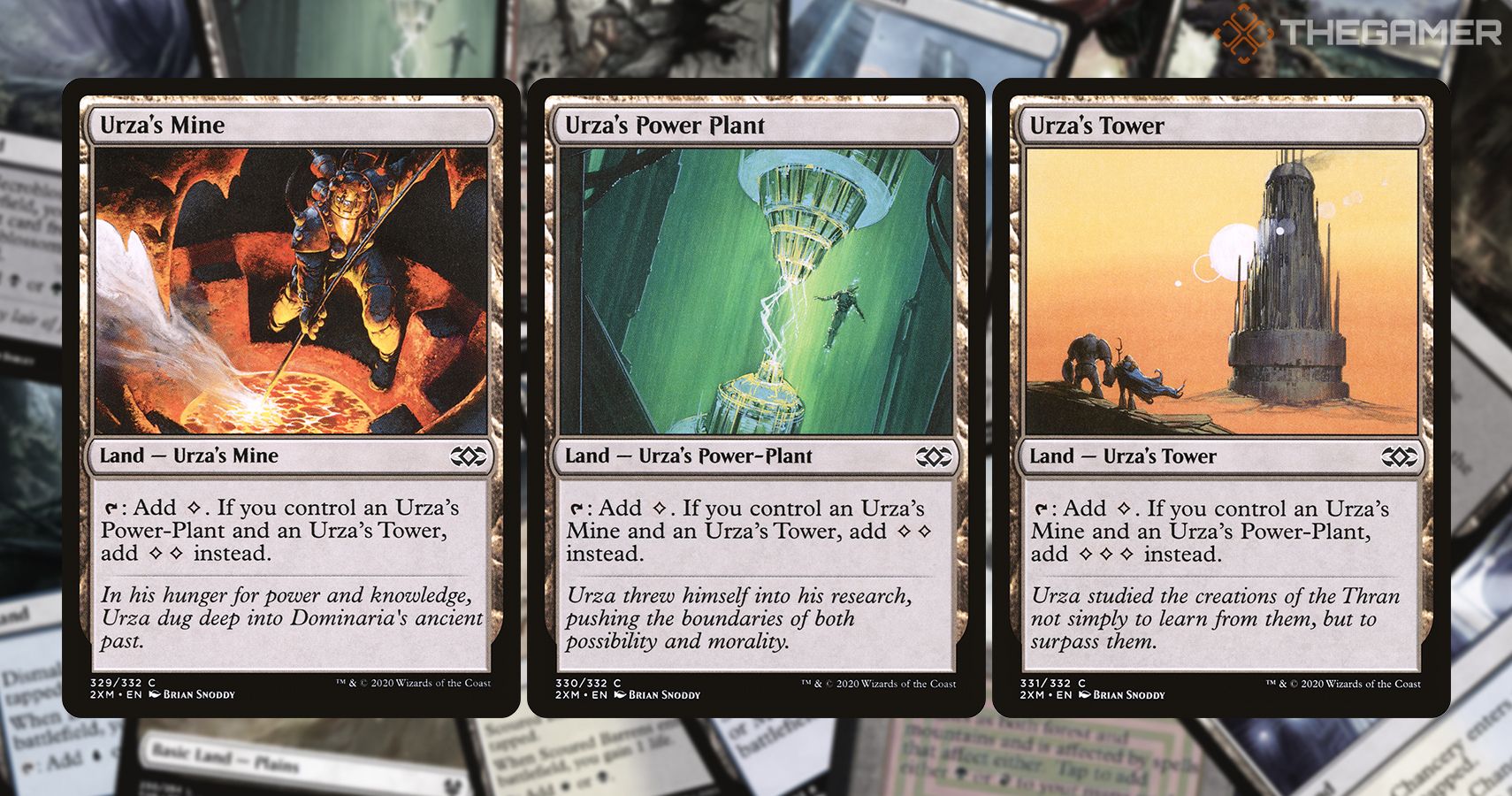
The last lands you're commonly likely to run into are the three "Urza's ___" lands. Though individually they don't do much, when they're combined they can produce massive amounts of mana. Decks that are focused on assembling all of the Urza's Lands are generally known as "Tron Decks", due to the similarities to the mecha cartoon Voltron.
Because Magic slang is vague and confusing, there are also Voltron Decks that instead assemble equipment artifacts instead, but Tron and Voltron are two very different things
The Urza Lands are:
- Urza's Mine
- Urza's Power Plant
- Urza's Tower
There are two cards from Modern Horizons 2 that reference Tron lands without being part of it: Urza's Saga and Mishra's Factory.
hendersonplingers.blogspot.com
Source: https://www.thegamer.com/magic-the-gathering-lands-explained-fetch-shock-dual-lands/
0 Response to "Mtg Land That Gives Blue Black and Red"
Postar um comentário